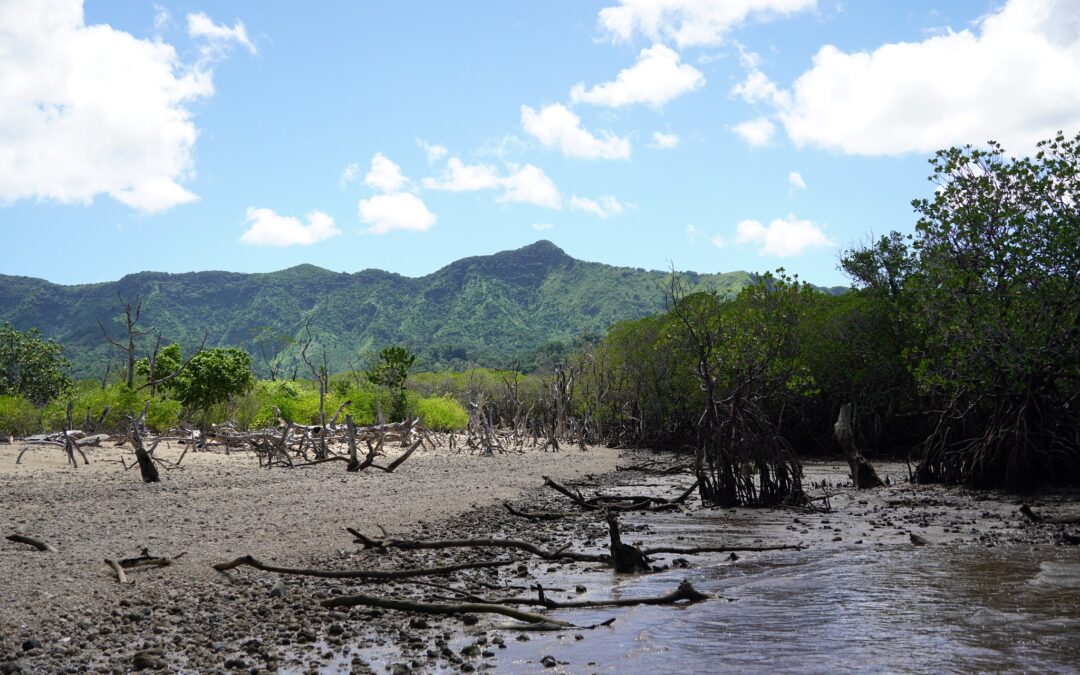Mangroves are nature’s superheroes. In Comoros, much like on many coasts along the Western Indian Ocean, protecting and restoring mangroves is both a conservation priority and a critical climate action, contributing to a more resilient and sustainable future for people and nature.
Moheli has the highest mangrove cover in Comoros, covering 85 hectares stretching from Mirigoni in the west to Itsamia in the east. These are made up of coastal and estuarine mangroves hosting various species.
“The Nioumachoua site is the largest in terms of both area and species diversity, and it is bordered on both sides by undisturbed mangrove patches,” explains Mr Fahade Said Manini, Mission Officer for Forests, Watersheds, and Associated Species / Operations Center, Data Management, GIS, and IT, Mohéli National Park.
“The most dominant and vigorous plant species belong to the Rhizophora genus, with the majority reaching heights above five meters.”
Mohéli’s mangroves harbor rich biodiversity, serving as nurseries, refuges, and breeding grounds for numerous species of fish, crustaceans, mollusks, birds, reptiles, and mammals. Most of these animals are not exclusive to mangroves but use them as shelter, feeding grounds, and reproductive sites. Notably, fish and crabs are of socioeconomic importance to nearby communities.
“Mangroves contribute to local fisheries by enhancing fish stocks. Crabs are either sold to tourists, used as bait by fishers, or occasionally consumed by a minority of the local population,” said Mr Fahade Said Manini.
“These rich coastal forests sustain marine life, support local fisheries, store carbon, and provide essential livelihoods, particularly for women and youth involved in fishing, eco-tourism, and traditional practices,” added Loubna Hamidi, Blue Nature Lead, IUCN, Comoros.
They also play a vital role as the first line of defence against coastal erosion, rising sea levels, and extreme weather events, helping to protect vulnerable island communities and preserve biodiversity. Nevertheless, these ecosystems face mounting threats from overharvesting, land conversion, pollution, and the impacts of climate change.
“Mohéli’s mangroves are vulnerable ecosystems, with their vulnerability driven by two main factors – climatic and non-climatic factors.” explained Mr Fahade Said Manini.
Climatic factors include rising temperatures, decreased rainfall, cyclone and storm variability and sea-level rise. Non-climatic factors include habitat degradation upstream, erosion, sedimentation and human pressure, such as mangrove wood harvesting.
Among the three main non-climatic factors, erosion is by far the most visible and destructive, particularly at the Nioumachoua site, which is characterized by strong waves and large swells that push back the shoreline and move massive sediment loads into mangrove zones. Agricultural expansion has led to watershed degradation near mangroves. Torrential rain during monsoons is also a threat.
The ReSea Project is responding to these threats emphasizing inclusive, gender-responsive approaches that build local capacity, foster stewardship, and enhance climate resilience.
“With the support of Global Affairs Canada, the ReSea Project continues to scale its impact by promoting the conservation and restoration of coastal and marine ecosystems, protecting key habitats for marine species, and providing physical protection for coastal communities,” said Loubna.
“The initiative also creates inclusive economic opportunities, with a strong focus on empowering women and youth. In Moheli, the Nioumachoua site has been designated as a Nature-based Solutions (NbS) demonstration site, showcasing effective, community-led conservation that links ecosystem health with sustainable blue economy practices.”
As we mark the International Day for the Conservation of Mangroves, we call upon governments, civil society, and the private sector to accelerate and scale up investments in locally driven, inclusive solutions that protect mangroves and the communities that depend on them.
“This day presents a valuable opportunity to raise widespread awareness among local communities about the importance of mangroves in our daily lives, especially for island nations like the Comoros,” said Mr Mouktafi Said Ramadane, Regional Director of Environment and Forest in Moheli Seascape.
“The ReSea Project, funded by the Government of Canada, supports us in the marine landscape of Mohéli by promoting awareness and advancing nature-based solutions (NbS). The inclusion of local communities, in close collaboration with local stakeholders, is essential for building a sustainable blue economy that meets the needs of the territory while respecting the environment.”

